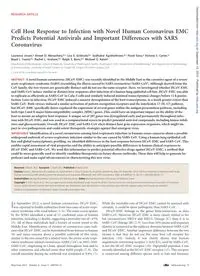
2013 Cell Host Response to Infection with Novel Human Coronavirus EMC Predicts Potential Antivirals and Important Differ PDF
Preview 2013 Cell Host Response to Infection with Novel Human Coronavirus EMC Predicts Potential Antivirals and Important Differ
Cell Host Response to Infection with Novel Human Coronavirus EMC Predicts Potential Antivirals and Important Differences with SARS Coronavirus Laurence Josset,a Vineet D. Menachery,b,c Lisa E. Gralinski,b,c Sudhakar Agnihothram,b,c Pavel Sova,a Victoria S. Carter,a Boyd L. Yount,b,c Rachel L. Graham,b,c Ralph S. Baric,b,c Michael G. Katzea Department of Microbiology, School of Medicine, University of Washington, Seattle, Washington, USAa; Department of Epidemiologyb and Department of Microbiology and Immunology,c University of North Carolina at Chapel Hill, Chapel Hill, North Carolina, USA L.J. and V.D.M. contributed equally to this work. ABSTRACT A novel human coronavirus (HCoV-EMC) was recently identified in the Middle East as the causative agent of a severe acute respiratory syndrome (SARS) resembling the illness caused by SARS coronavirus (SARS-CoV). Although derived from the CoV family, the two viruses are genetically distinct and do not use the same receptor. Here, we investigated whether HCoV-EMC and SARS-CoV induce similar or distinct host responses after infection of a human lung epithelial cell line. HCoV-EMC was able to replicate as efficiently as SARS-CoV in Calu-3 cells and similarly induced minimal transcriptomic changes before 12 h postin- fection. Later in infection, HCoV-EMC induced a massive dysregulation of the host transcriptome, to a much greater extent than SARS-CoV. Both viruses induced a similar activation of pattern recognition receptors and the interleukin 17 (IL-17) pathway, but HCoV-EMC specifically down-regulated the expression of several genes within the antigen presentation pathway, including both type I and II major histocompatibility complex (MHC) genes. This could have an important impact on the ability of the host to mount an adaptive host response. A unique set of 207 genes was dysregulated early and permanently throughout infec- tion with HCoV-EMC, and was used in a computational screen to predict potential antiviral compounds, including kinase inhib- itors and glucocorticoids. Overall, HCoV-EMC and SARS-CoV elicit distinct host gene expression responses, which might im- pact in vivo pathogenesis and could orient therapeutic strategies against that emergent virus. IMPORTANCE Identification of a novel coronavirus causing fatal respiratory infection in humans raises concerns about a possible widespread outbreak of severe respiratory infection similar to the one caused by SARS-CoV. Using a human lung epithelial cell line and global transcriptomic profiling, we identified differences in the host response between HCoV-EMC and SARS-CoV. This enables rapid assessment of viral properties and the ability to anticipate possible differences in human clinical responses to HCoV-EMC and SARS-CoV. We used this information to predict potential effective drugs against HCoV-EMC, a method that could be more generally used to identify candidate therapeutics in future disease outbreaks. These data will help to generate hy- potheses and make rapid advancements in characterizing this new virus. Received 5 March 2013 Accepted 12 April 2013 Published 30 April 2013 Citation Josset L, Menachery VD, Gralinski LE, Agnihothram S, Sova P, Carter VS, Yount BL, Graham RL, Baric RS, Katze MG. 2013. Cell host response to infection with novel human coronavirus EMC predicts potential antivirals and important differences with SARS coronavirus. mBio 4(3):e00165-13. doi:10.1128/mBio.00165-13. Invited Editor Michael Buchmeier, University of California, Irvine Editor Michael Buchmeier, University of California, Irvine Copyright © 2013 Josset et al. This is an open-access article distributed under the terms of the Creative Commons Attribution-Noncommercial-ShareAlike 3.0 Unported license, which permits unrestricted noncommercial use, distribution, and reproduction in any medium, provided the original author and source are credited. Address correspondence to Michael G. Katze,
